AARP Eye Center
Disrupting Disparities
Download and view all of AARPNY's Disrupt Disparities reports:
1. Disrupt Disparities: Addressing the Crisis for Rural New Yorkers 50+ 2.0
2. Disrupt Disparities: Addressing the Crisis for Rural New Yorkers 50+
3. Disrupt Disparities Kinship Care in Crisis.
4. Disrupt Disparities LGBTQ
5. Disrupt Disparities 3.0
6. Disrupt Disparities 2.0
7. Disrupt Disparities 1.0
Disrupt Disparities: Addressing the Crisis for Rural New Yorkers 50+ 2.0: December 6, 2022
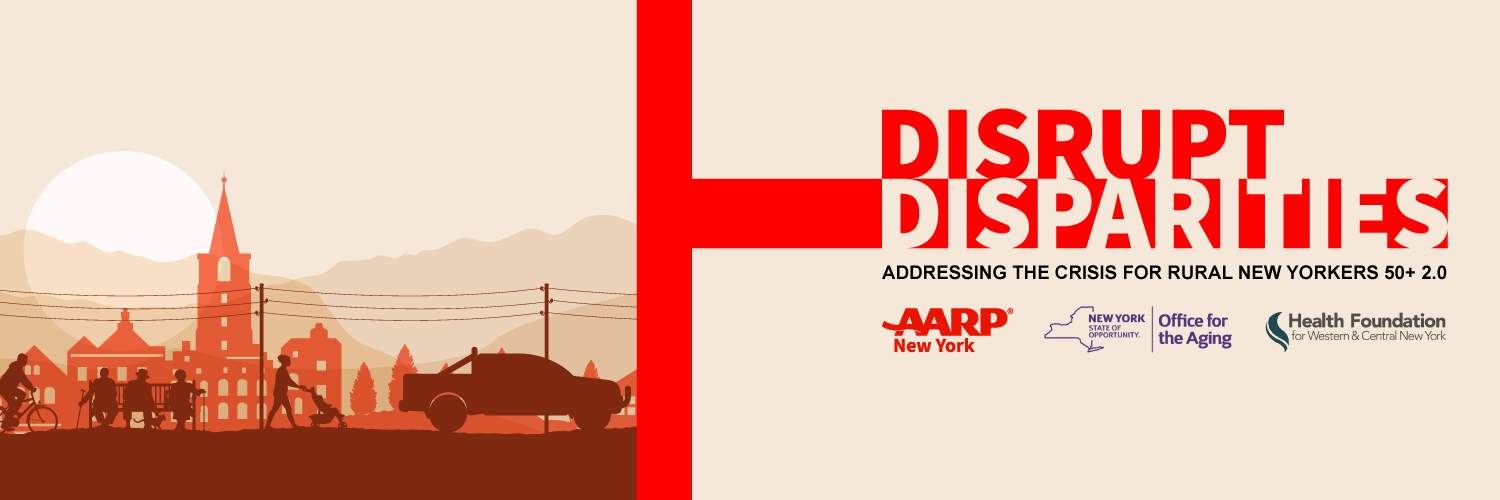
Older rural New Yorkers are struggling to age in place due to a dearth of affordable and accessible housing, while many older adults who no longer drive or don’t have access to public transportation or privately owned vehicles face numerous challenges in obtaining rides to such essential services as medical appointments and grocery stores.
These trends pose significant challenges and demand solutions, according to a new research report and policy paper released by AARP New York.
The housing and transportation report follows last year’s AARP New York research report that found older rural New Yorkers are sicker, more disabled, and have less access to healthcare and high-speed internet than those living in urban and suburban areas. The policy report released in November 2021 focused on health, caregiving, telehealth and broadband as they impact rural New York, a sprawling area with over a million residents - more people than six states and Washington, D.C.
The report noted that about 1 in 5 homeowners and nearly half of renters in rural areas of New York State are spending more than 30% of their income on housing. And many rural areas of the state have limited or no public transit services. Access to demand-response transportation (DRT) options such as taxis and app-based ride-hailing services is often spotty or non-existent.
Click here to: Download the full version of our Rural Disrupt Disparities Report and Infographics.
- Housing:
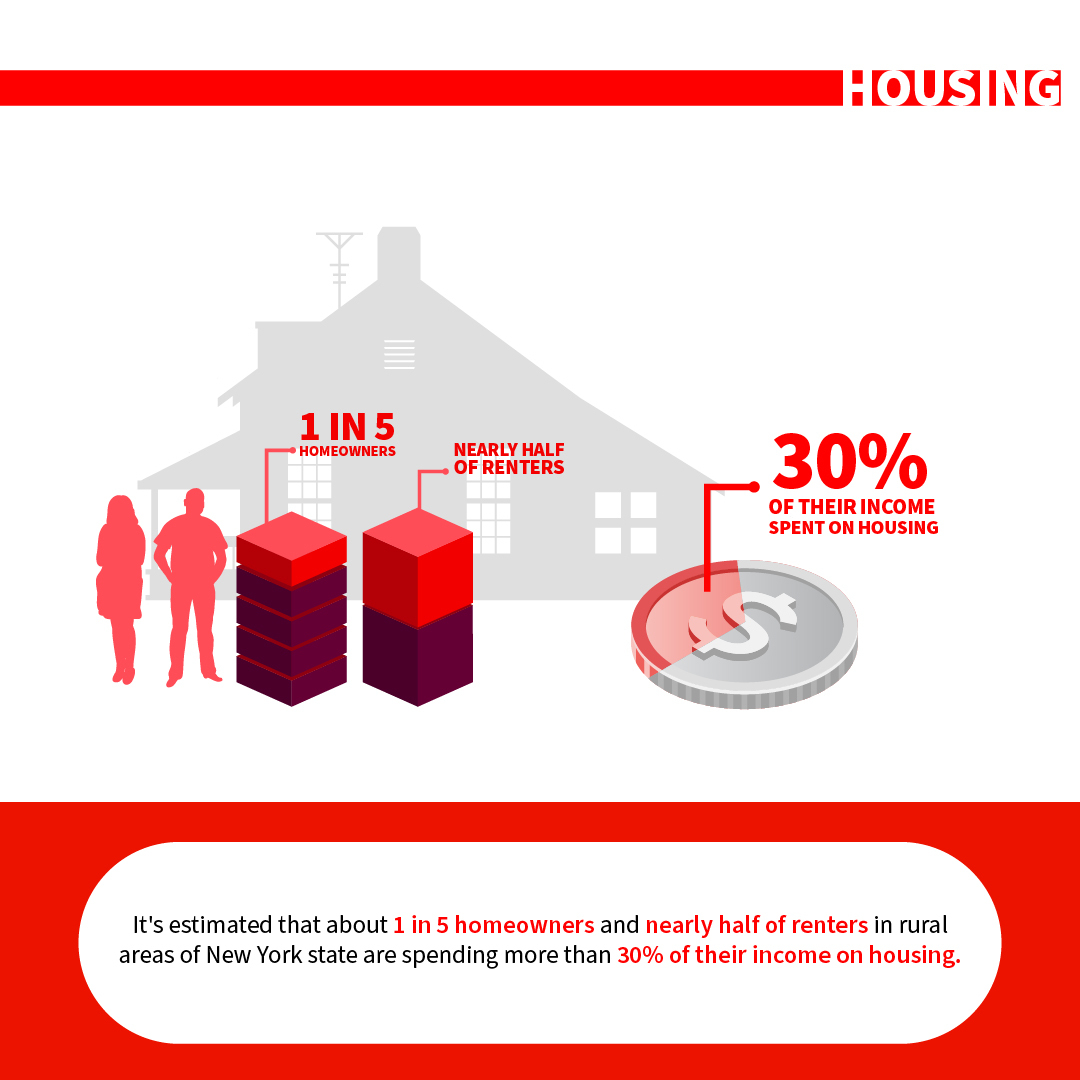
- Transportation
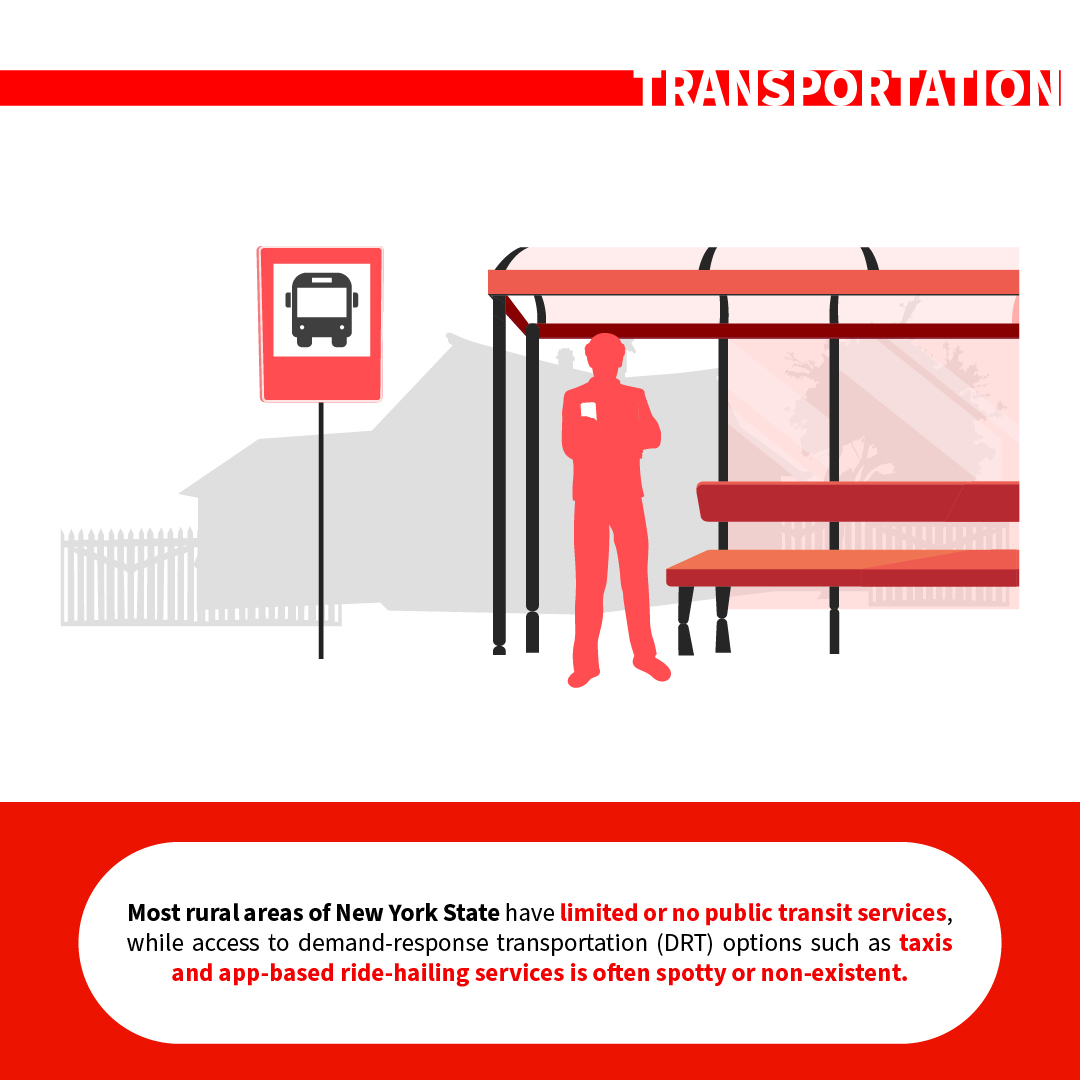
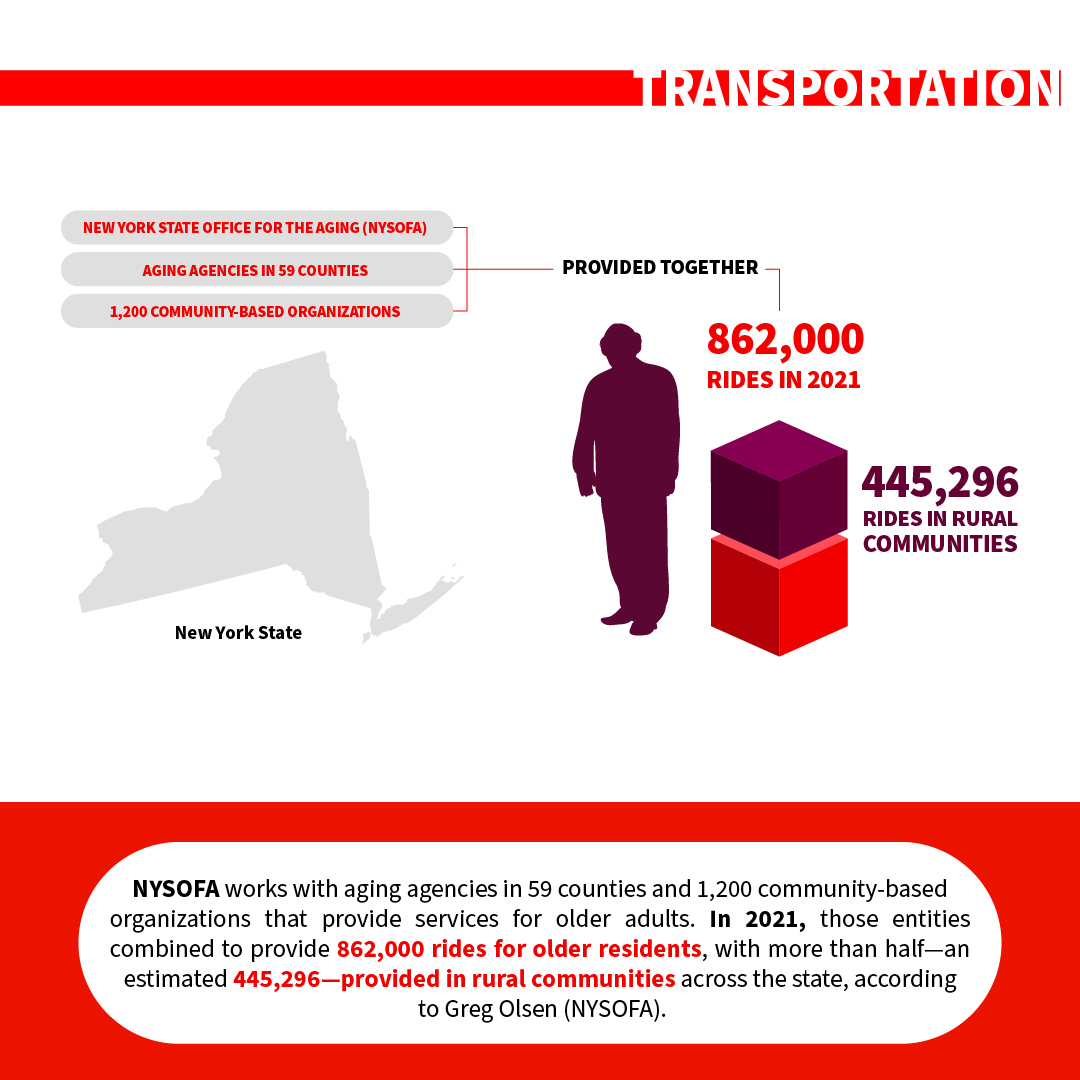
- New York State's Rural Population 50+
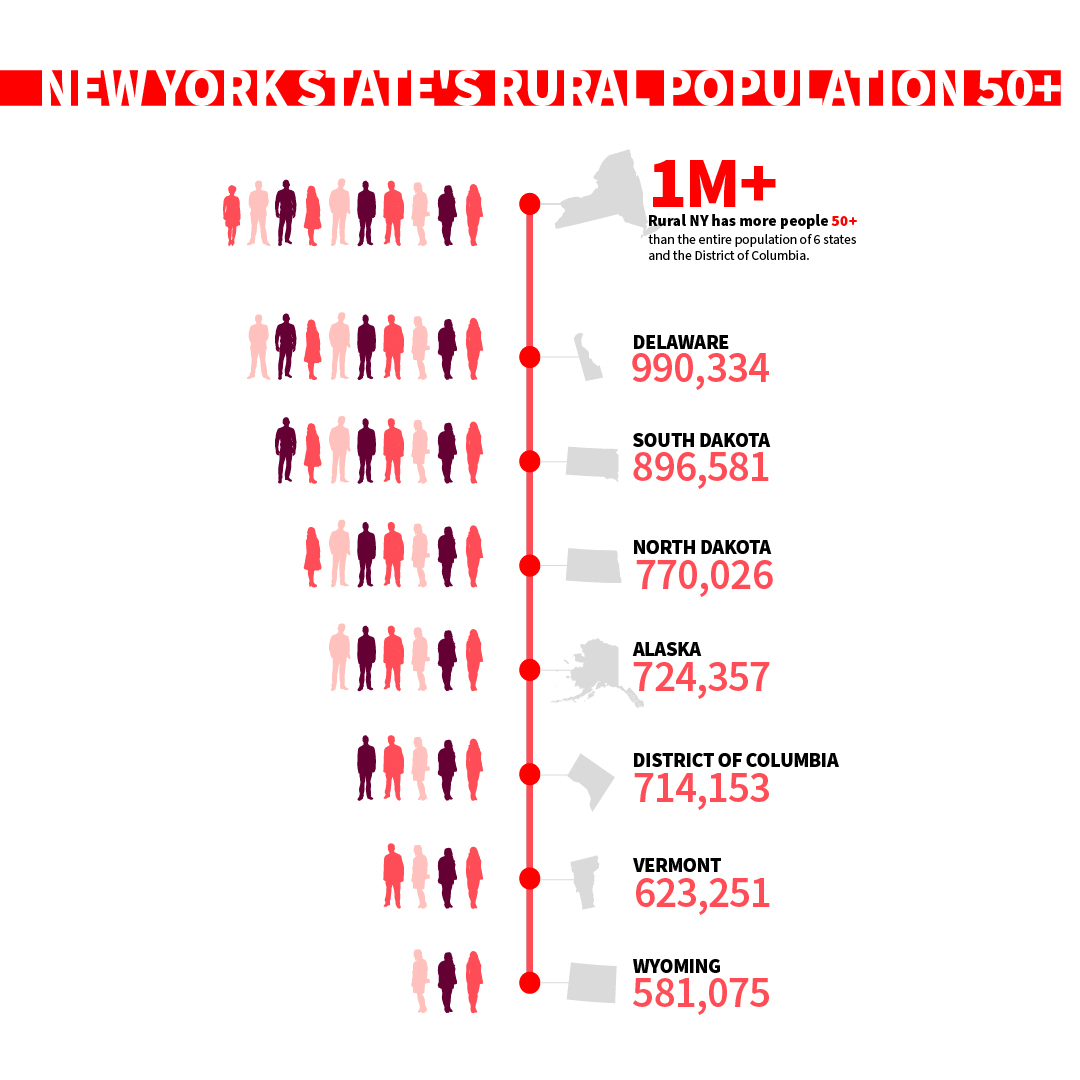
_____________________________________________________________________________________
Disrupt Disparities: Addressing the Crisis for Rural New Yorkers 50+ – November 9, 2021

Older rural New Yorkers are sicker, more disabled, and have less access to healthcare and high-speed internet than those living in urban and suburban areas. And as the population of rural New York grows older with the aging of the Baby Boom generation and an influx of retirees, younger residents leave for jobs elsewhere.
These trends pose significant challenges and demand solutions, according to a new research report: Disrupt Disparities – Addressing the Crisis for Rural New Yorkers 50+ and policy paper from AARP New York.
Disrupt Disparities: Addressing the Crisis for Rural New Yorkers 50+ is the latest in AARP New York’s multi-year initiative Disrupting Racial and Ethnic Disparities: Solutions for New Yorkers 50+, which began in January 2018.
“The pandemic has exacerbated the disparities rural New Yorkers have long faced, such as greater social and geographic isolation and less access to healthcare, nutritious food and increasingly critical high-speed internet,” said AARP New York State Director Beth Finkel. “This report not only documents these and other disparities, it provides achievable solutions. AARP New York fully supports these efforts to make rural New York a more livable place for the 50-plus and residents of all ages.”
“As this new report from our partners at AARP New York demonstrates, older adults in rural areas across New York continue to face inequities in health care, food, transportation, and other social determinants of health, and those conditions are linked to poorer health outcomes,” said Nora O'Brien-Suric, PhD, President, the Health Foundation for Western & Central New York. “This insightful research underscores the continued need for policies, investments and programs that strengthen the health of rural communities and improve the lives of older adults and caregivers across New York State.”
The new report focuses on health, caregiving, telehealth and broadband as they impact rural New York, a sprawling area with over a million residents - more people than six states and Washington, D.C.
Click here to: Download the full version of our Rural Disrupt Disparities Report.
Download the full version of our Rural Disrupt Disparities Infographics.
______________________________________________________________________________________________
Disrupt Disparities Kinship Care in Crisis – March 19, 2021
Non-parent relatives raising children in New York – disproportionately African American and mostly grandparents – face multiple disparities while performing an already tough task, according to Disrupt Disparities: Kinship Care in Crisis, a new report commissioned by AARP New York, the NAACP New York State Chapter, New York Urban League, Hispanic Federation and Asian American Federation.
“Non-parent relatives who raise children perform heroic work, not only for their families but for society,” said AARP New York State Director Beth Finkel. “But kinship caregivers need help.”
“The many grandparents in our African American communities who are raising their grandchildren perform a labor of love, but it’s a hard, virtually full-time job,” said NAACP New York State Chapter President Hazel Dukes.
“The NYS KinCare Coalition, led by the NYS Kinship Navigator in partnership with local kinship programs, provides much needed support to the estimated 195,000 kinship children in New York State,” said NYS Kinship Navigator Director Rae Glaser. “Children find stability, permanency, and overall better outcomes in the care of relatives and family friends. Kinship Care is a ‘natural resource’ and has been pivotal during the past year for families affected by the COVID-19 pandemic.”
Across New York State, 14 local kinship programs serve 25 counties, while the statewide Kinship Navigator serves the rest.
The report shows:
- Only 15% of eligible children in New York receive the $430-a-month federal “Non-Parent” grant for which they qualify.
- Nationally, one in five African American/Black children will live in a kinship home during their childhood – more than double the one in 11 average.
- 21.1% of grandparents caring for children in New York have income under the federal poverty line, while half of all single grandmothers raising grandchildren live in poverty - with grandmothers more likely to be caregivers than grandfathers.
- Less than one third of eligible grandparent-headed households receive housing assistance.
- Older kinship caregivers are even less likely than other low-income New Yorkers to know what supports they are eligible for, such as housing, legal assistance, financial benefits, child care and the Non-Parent Grant (for which the application process is complex and lengthy and for which eligibility guidelines differ across counties), or how to apply; many are uncomfortable with the internet and online applications.
- Lack of legal ability to enroll children in school, make educational or medical decisions for children, take them to the doctor or obtain documents such as birth certificates can keep families from achieving stability.
Despite all these obstacles, 46% of grandparents raising their grandchildren have had them for at least five years. And grandparents and other kinship caregivers are more likely to provide a permanent home and help children maintain connections to siblings and other extended family while remaining connected to a sense of cultural identity. These factors lead to better behavioral and mental health outcomes in the short-term, and decreased adverse health effects in adulthood.
Kinship caregivers are raising about 195,000 children in New York, with 96% doing so outside of foster care - which limits their access to the resources, supports, and benefits foster parents receive.
About 65% of all kinship caregivers in New York are grandparents caring for their grandchildren – some 120,376 grandparents in all, according to the American Community Survey.
The report included a number of policy recommendations made in advance of the finalization of New York’s 2021-22 State Budget.
Click here to: Download the full version of our Kinship Infographics.




___________________________________________________________________________________________________
Disrupt Disparities LGBTQ - January 28, 2021
AARP NY, AARP Foundation & SAGE presents Disrupt Disparities: Solutions for LGBTQ New Yorkers Age 50+ - January 28, 2021
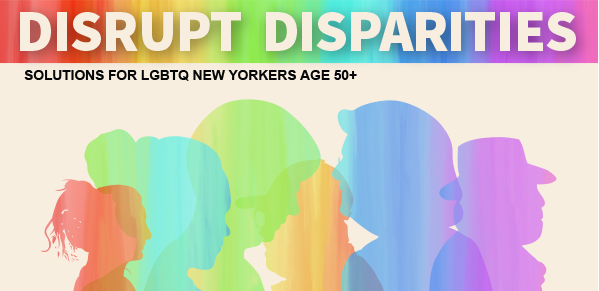
Update, November 2023: Governor Kathy Hochul signed an AARP NY-backed bill (S.1783A/A.372A) to establish a bill of rights for long-term care facility residents who are lesbian, gay, bisexual, transgender, or living with HIV. The bill prohibits long-term care facilities and their staff from discriminating against any resident on the basis of a resident’s actual or perceived sexual orientation, gender identity or expression, or HIV status, and requires facility staff to undergo cultural competency training.
A new report shows health, savings, housing hurdles, and poverty still plague LGBTQ 50+ New Yorkers - 51 years after Stonewall – and they’ve grown worse since the COVID-19 pandemic started.
New York State ranks among the top 10 states in terms of the percentage of its population that is lesbian, gay, bisexual, and/or transgender (LGBTQ). Of the estimated 800,000 LGBTQ adults in New York State, nearly one-third (28%) are over the age of 50. These older LGBTQ New Yorkers contribute to the diversity of New York State. LGBTQ older people live in urban and rural communities across the state, are part of every racial and ethnic group, are veterans, are immigrants, and are living with disabilities. And the population of LGBTQ older New Yorkers is only expected to grow as the population ages: by 2030, 1 in 5 New Yorkers are expected to be over age 60.
The Stonewall generation fought for LGBTQ rights, but this rapidly growing elder population still faces disparities rooted in discrimination, a lack of legal and social recognition, a reliance on chosen family, reduced access to inclusive services, and other social barriers to health and well-being. While LGBTQ older people are resilient, these and other unique challenges have severe negative health, economic, and social implications that demand action.
Although a key part of New York State’s rapidly growing elder population, LGBTQ older people remain largely invisible. Many are isolated and disconnected from services in part because LGBTQ older people are far more likely to live alone than non-LGBTQ individuals and far less likely to rely on adult children or other family members for informal caregiving. AARP Foundation supported research found that half of LGBTQ adults age 45 and older are lonely, and intersecting identities only exacerbate the prevalence of loneliness.
According to the AARP’s Maintaining Dignity study, three out of four LGBTQ people age 45 and older were concerned about having enough support from family and friends as they age. Thin support networks mean that LGBTQ older people are more likely to rely on community service providers as they age, even though many are distrustful of providers due to the fact that LGBTQ older people face discrimination when accessing health and social services.
Fear of discrimination can lead LGBTQ older people to delay seeking needed care and can lead to premature institutionalization in nursing homes and long-term care facilities due to fear of hostile in-home care providers. The Maintaining Dignity study found that majorities of LGBTQ people age 45 and older have concerns about long-term care, including concerns about neglect (67%), abuse (62%), verbal or physical harassment (61%), refusals or limits on services (61%), and being forced to hide or deny their identity (52%). LGBTQ older people also experience significant health disparities that include reduced access to health care, mental health concerns, and chronic physical conditions.
Many of these concerns are compounded for LGBTQ older people of color who face even greater disparities and those living with HIV who face additional stigma and privacy concerns. Disparities for LGBTQ older people of color have long existed but have been laid bare at a time of renewed focus on systemic racism in response to the murders of George Floyd, Breonna Taylor, Ahmaud Arbery, Tony McDade, and countless others.
Given the unique challenges faced by LGBTQ older people, AARP commissioned this report to 1) identify the disparities faced by New York State’s 50-plus LGBTQ population; and 2) develop concrete policy solutions to address these disparities. This report includes both, but notes that the lack of comprehensive LGBTQ data remains a major limitation. While this report discusses available information, additional data is needed to fully understand and respond to LGBTQ-specific disparities in New York’s 50-plus population.
This new report includes an array of policy and legislative solutions that can serve as a roadmap for elected officials and policymakers primarily at the State but also at local levels of government - as with AARP New York’s launch of the Disrupt Disparities initiative in January 2018, Disrupt Disparities 2.0 in January 2020 and Disrupt Disparities 3.0 in November 2020.
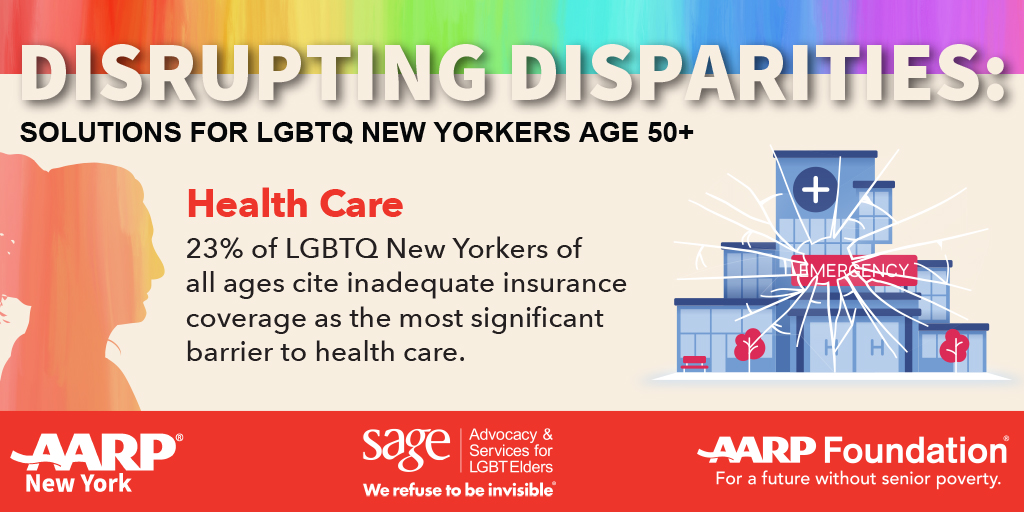


___________________________________________________________________________________________________
Disrupt Disparities 3.0 - November 17, 2020
Information is also available in
Learn more about our findings in our booklet: Disrupt Disparities 3.0 . The data that we compiled on topics such as: Health, Housing and Hunger can be found in our: Disrupt Disparities 3.0 Infographic.
Older New Yorkers of color have fallen behind on rent payments and are struggling with food insecurity at far greater rates than their white counterparts during the COVID-19 pandemic.
Nursing homes with at least a quarter of African American or Latino residents have been twice as likely to be hit by COVID-19 than those with less than five percent of African American and Latino residents.
These findings and more are part of Disrupting Racial & Ethnic Disparities 3.0, the latest in a multi-year effort aimed at leveling the playing field for older New Yorkers of color.
AARP New York, the NAACP New York State Conference, New York Urban League, Asian American Federation and Hispanic Federation released Disrupt Disparities 3.0 at a virtual event on November 17, 2020 featuring Hip Hop Legend Doug E. Fresh, U.S. Representative Hakeem Jeffries of Brooklyn, key New York State lawmakers, healthcare workers union 1199SEIU and Hunger Solutions.
The virtual press conference featuring Doug E. Fresh can be viewed here: https://twitter.com/AARPNY/status/1328706138519474177?s=20
“This report shows what we’ve heard for months: that older New Yorkers of color have been disproportionately impacted by the COVID-19 pandemic both in terms of their health and their financial security,” said AARP New York State Director Beth Finkel. “COVID-19 has exposed and exacerbated the disparities we’ve been documenting for years. We and our collaborators will keep fighting to make things right for all New Yorkers.”
“Too often, when New York catches a cold, communities of color catch a fever,” said Rep. Hakeem Jeffries. “This report only highlights the pain, suffering and death that our Black, Hispanic and Asian American neighbors have faced this year. New Yorkers need comprehensive relief now, and we must ensure that any relief provided will help disrupt the racial and ethnic disparities within our state and nation. I thank AARP New York, the NAACP New York State Conference, New York Urban League, Asian American Federation and Hispanic Federation for their dedicated work on behalf of older New Yorkers of color."
“Our communities have endured decades of disparities, and COVID-19 has made them even worse,” said Doug E. Fresh. “In everything I do, I have always been all about uplifting the community, and I’m clear that this is what AARP New York, the New York Urban League, the New York State NAACP, the Asian American Federation, and the Hispanic Federation are doing through Disrupt Disparities. Lending my voice and support to this initiative to get some things done for the betterment of the community is the right thing to do.”
“The road toward justice is long, and there are always setbacks; COVID-19 is certainly one,” said NAACP New York President Hazel Dukes. “We must redouble our efforts toward progress. It is tough, unglamorous, incremental policy work, but we stand proudly with AARP and our fellow organizations to continue fighting for New York’s 50+ people of color.”
“People of color 50 and older in New York’s urban centers have been at the center of the crosshairs of a pandemic that thrives on densely populated areas,” said New York Urban League President & CEO Arva Rice. “The pandemic has exacerbated the stark disparities we documented in earlier reports. We are proud of what our Disrupt Disparities initiative has already accomplished, but we need to implement additional policy changes to close the gaps widened by our new reality and ensure equality for all, regardless of race or ethnicity.”
“The pandemic has not only exacerbated disparities affecting older New Yorkers of color but also the problem of lack of reliable data about the Asian American community,” said Asian American Federation Executive Director Jo-Ann Yoo. “One of this initiative’s ongoing aims is to shed light on how issues ranging from healthcare to food insecurity and housing affordability impact Asian American New Yorkers.”
“Our first two Disrupt Disparities reports drove significant changes in state policies aimed at improving the lives of New York’s Latino population,” said Hispanic Federation President Frankie Miranda. “The pandemic has forced us to renew our focus to address the historical inequities that have exacerbated the disproportionate impacts on Latino communities. We are ready to work with AARP and our fellow collaborators to achieve that end.”
Specifics from the report:
- Half of Black tenant households in New York State fell behind on their rent as of late May/early June 2020;
- About 25% of Black and Latino families reported not being able to pay their rent in May 2020 vs. 14% of White households;
- Even before the pandemic, Asian Americans nationally suffered higher rates of poverty than whites, while Asian Americans in New York City consistently faced higher rates of income poverty, material hardship and health problems than whites from 2014 through 2018.
- 39% of Black families and 37% of Hispanic families are struggling with food insecurity vs. 25% of New York City’s population at large.
- The number of New York City residents facing food insecurity has nearly doubled since the onset of the pandemic, from 1.2 million to nearly 2.2 million, roughly 25% of the population.
- Unemployment rates reached nearly 19% in April among Latinos and 17% among Blacks;
- Unemployment in The Bronx reached 24.9% in July 2020
- COVID-19 is widening housing disparities by race and income.
As with the initial launch of the Disrupt Disparities initiative in January 2018 and Disrupt Disparities 2.0 in January 2020, Disrupt Disparities 3.0 includes an array of policy and legislative solutions that can serve as a roadmap for elected officials and policymakers primarily at the state but also at local levels of government.
Among the recommendations:
- An independent review of the state’s handling of nursing homes and other long-term care facilities since the onset of the pandemic and a task force of stakeholders to promote models for improvement;
- Adequately funding cost-effective home and community-based services, which help New Yorkers age in their own homes rather than much costlier and mostly taxpayer-funded nursing homes;
- Enhancing enrollment in the federal Supplemental Nutrition Assistance Program and ensuring recipients can shop for food on line and have it delivered to their homes;
- Ensuring a lawyer for any renter with income up to 400% of the federal poverty to help fight unwarranted evictions, and;
- Establishing a housing access voucher program for New Yorkers who are homeless or face an imminent loss of housing.
___________________________________________________________________________________________________
Disrupt Disparities 2.0 - January 30, 2020

Updates for Disrupt Disparities 2.0 - January 30, 2020
Older New Yorkers of color are more threatened by gentrification, more likely to skip prescription medications because of cost, more burdened by utility bills, and more financially squeezed by the responsibilities of family caregiving than older White New Yorkers.
That’s the takeaway from “Disrupt Disparities 2.0,” the second phase of a multi-year initiative by AARP New York, the Asian American Federation, the Hispanic Federation, the NAACP of New York and the New York Urban League, examines disparities impacting New Yorkers of color 50+ in the areas of health, economic security and livability.
AARP and its partner groups released Disrupt Disparities 2.0, a conglomeration of research into gentrification, prescription drug affordability, and family caregiving and utility costs, at a media luncheon today at the Yale Club featuring Assembly Members Yu-Line Niou and Robert Rodriguez of Manhattan.
“Whether it’s housing, prescription drugs, utilities or caring for a loved one, older New Yorkers of color face longer odds when it comes to affordability and access,” said AARP New York State Director Beth Finkel. “We’ve made significant progress since we launched ‘Disrupt Disparities’ in 2018, but ‘Disrupt Disparities 2.0’ shows we need to do more to level the playing field so all New Yorkers have equal opportunities.”
“Most striking among the findings is the dearth of data about the Asian American community on key topics like housing, utilities and caregiving,” said Asian American Federation Executive Director Jo-Ann Yoo.
“The initial Disrupt Disparities reports drove significant changes in state policies that will improve the lives of New York’s Hispanic population,” said Hispanic Federation President & CEO Frankie Miranda. “Together with AARP, we are excited to build on those early successes through this new research and policy ideas.”
“As the heroes of the Civil Rights Movement showed us, progress comes – sometimes quickly and dramatically, but more often through tough, unglamorous, incremental policy work,” said NAACP New York President Hazel Dukes. “The time to get to work is long past, and we stand proudly with AARP to support New York’s 50+ people of color.”
“People of color 50 and older experience stark disparities across their health, homes and neighborhoods, particularly in New York’s urban centers,” said New York Urban League President Arva Rice. “We are proud of what this initiative has already accomplished, and look forward to implementing more policy changes to close the gaps and ensure equality for all, regardless of race or ethnicity.”
Learn more about our findings in our booklet: Disrupt Disparities 2.0
The data that we compiled on topics such as: Utilities, Gentrification, Rx and Caregiving can be found in our: Disrupt Disparities 2.0 Infographic
Additionally, you can read more on our: Racial and Ethnic Disparities in Rent-Regulated Housing for 50-Plus New Yorkers.
___________________________________________________________________________________________________
Disrupt Disparities 2019

New York State has long been home to some of the most ethnically diverse neighborhoods in the nation. New York’s ethnic communities—primarily comprised of African American/Black, Asian American/Pacific Islander and Hispanic/Latino populations are not only growing, but also aging at a rapid pace. Given these changing demographics, AARP is partnering with thought leaders, elected officials and leading organizations that serve New York’s ethnic communities in a multi-year effort to identify disparities that exist among their ethnic 50-plus communities and fight for solutions to disrupt these disparities. AARP’s purpose has always been to empower people to choose how to live as they age.
Through a societal movement called Disrupt Aging, AARP encourages all to challenge outdated beliefs and spark new solutions to facilitate peoples’ choices. However, key disparities that exist in the areas of health, economic security and livability among 50-plus New Yorkers of color create inequalities that can limit or even impede their choices.
On January 24, 2018, AARP New York, the Asian American Federation, the Hispanic Federation, the NAACP and the Urban League released a series of policy briefs highlighting disparities in health, economic security, and livability in: AARP: DisrupDisrupt Disparities 1.0upt Disparities - Spanish , and AARP - Disrupt Disparities - Chinese.
AARP New York is also partnering with the Rockefeller Institute of Government to dig deeper into disparities and develop additional solutions, and in early 2019 commissioned a new report on the aging of New York by the Center for an Urban Future. AARP and our partner groups have shed a light on the disparities in communities of color.
Until now, few, if any, proposed solutions have led to the necessary policy changes to address these disparities; nor have they focused on New York’s 50-plus population. But AARP and partners have made significant progress since January 2018, including:
- Enactment of the NYS Secure Choice program, which will allow private sector employers to offer their employees the chance to open individual retirement accounts with low-cost options through payroll deduction.
- An historic $15 million increase in funding for non-Medicaid home and community based services for the elderly in the 2019-20 state budget. These services, which include transportation to medical appointments and help with bathing, dressing and other daily activities, help relieve the burden on family caregivers and allow older New Yorkers to remain at home longer – where the vast majority want to be. National studies have shown that Americans of color have been moving to nursing homes – the majority of which are paid for by taxpayers - at an increasing rate while the percentage of whites moving to nursing homes has declined.
- $20 million in the 2019-20 state budget for housing and legal services for vulnerable homeowners fighting foreclosure, deed theft, and other challenges that threaten to displace them from their homes, replacing funding from bank settlements that ran out at the end of March 2019.
- The strongest rent regulation laws in the nation, signed in the spring of 2019.
- A ban on discrimination against any lawful source of income, such as Social Security checks, to pay for housing.
- Funding in the 2019-20 state budget for elder abuse prevention.
- Funding in the 2019-20 state budget for Kincare programs that help non-parent relatives raising children.
- Legislative passage of a bill making it easier for eligible children to receive a public assistance non-parent grant (the bill still needs the Governor’s approval).
- Legislative passage of a bill to create an independent utility consumer advocate with the power to challenge unfair rate hikes in court (the bill still needs the Governor’s approval).
There is much more to be done, and that is where YOU come in. We are looking to hear from you on additional policy solutions to help close the gaps that exist in communities of color. It is our goal that these solutions be put into action to help all communities enjoy the same stability and equal footing, thus offering more choices for how and where all New Yorkers live as they age. Share your thoughts and solutions with us by email at nyaarp@aarp.org. The conversation doesn’t end here. AARP and our partner groups will continue taking these briefings around New York State where we will engage with legislators, journalists, and key policy influencers.
Resources
Press Releases:
AARP Lauds Governor for Plan to Help Millions of Middle Class NYers Save for Retirement at Work
NYS Budget Includes $15 M Increase for Home & Community Services for Older NYers – Biggest in Nearly Two Decades; Will Help Thousands Avoid Nursing Homes
NY’s Communities of Color Have Less Access to Retirement Savings, Banks, Pay More for Caregiving, Housing; AARP, Partners Launch Policy Solutions Agenda
Major Step for Utility Consumers as Lawmakers Give Final Passage to Bill Creating Independent Advocate
New Rent Laws Protect, Preserve Affordable Housing to Keep NYS Livable for Older Residents
Retirement Un-Readiness: New Report Warns of ‘Downward Mobility’ for NY Near-Retirees
High Medical and Caregiving Costs, Poor Transportation Options Plague Buffalo’s 50+ Communities of Color
Hispanic/Latinos Lag in Income, Bank Accounts, Healthcare Access; Hostos Event Eyes Solutions
Fewer Bank Branches and Mortgages, Higher Housing Costs, Debt and Foreclosure Risk Plague Long Island’s 50+ Communities of Color
AARP: Secure Choice Will Help NYers Save at Work, Close Growing Retirement Savings Gap
100K+ NYers Face Potential Foreclosure Every Year; Advocates Urge Senate to Pass Consumer Protection Bill
Note: this bill passed the NYS Legislature in June 2019 and will go to the Governor.
In the News:
Sing Tao Daily
Sinovision
China Press
World Journal
World Journal (additional coverage)
DWnews.com
The Indian Panorama
El Diario
Telemundo
Univision
Harlem News
Carib News
Telemundo
Sofrito
MSN
Bronx Times
NY State of Politics
Capital Tonight - Spectrum News
Buffalo News
New York Business Journal
Long Island Exchange
Spectrum News Buffalo
WBFO/NPR
Buffalo Healthy Living
Queens Latino
Spectrum News Noticias NY 1
Long Island Exchange
Social Media Influencers:
Disrupting Racial and Ethnic Disparities for New Yorkers Age 50+ via @BiculturalMama
Disrupting Racial and Ethnic Disparities - AARP NY Reveals data by Sofrito for Your Soul
Calendar: Past Events:
January 24, 2018 - Disrupt Disparities launch at the CUNY Graduate Center
February 17, 2018 - AARP at the NY State Association of Black & Puerto Rican Legislators
February 20, 2018 - AARP at the State of Black America with WBLS
March 9 - 11, 2018 - AARP at the SOMOS conference in Albany
April 1, 2018 - Secure Choice passed - New York State Executive Budget
April 1, 2018 - Telehealth passed - New York State Executive Budget (Pages 124 - 126)
April 11, 2018 - AARP at Black Women Who Lead panel at the Schomburg Center
June 21, 2018 - AARP at Asian American Federation Poverty Conference
July 31, 2018 - AARP Partnership with Little Rock play/ Disparities in talk back after show
August 2, 2018 - AARP at Statewide Conference on Livability in Syracuse/ Disparities keynote
September 6, 2018 - Disrupt Disparities Event with Hofstra’s Suburban Studies Center
October 10, 2018 - East Side Listening Session at William Emslie Family YMCA (Buffalo, NY)
October 11, 2018 - West Side Listening Session at The Belle Center (Buffalo, NY)
October 25, 2018 - Disrupt Disparities Event with Hostos Community College
November 16, 2018 - Disrupt Disparities Summit in Buffalo, NY
December 6, 2018 - Disrupt Disparities in Retirement Readiness with The New School
















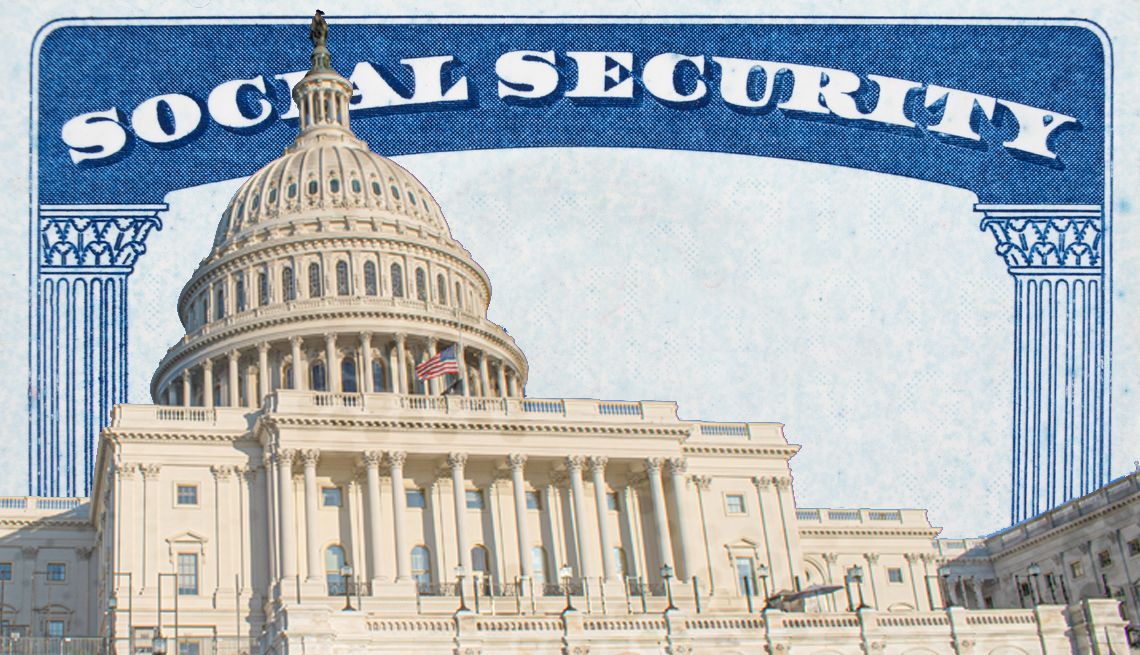)








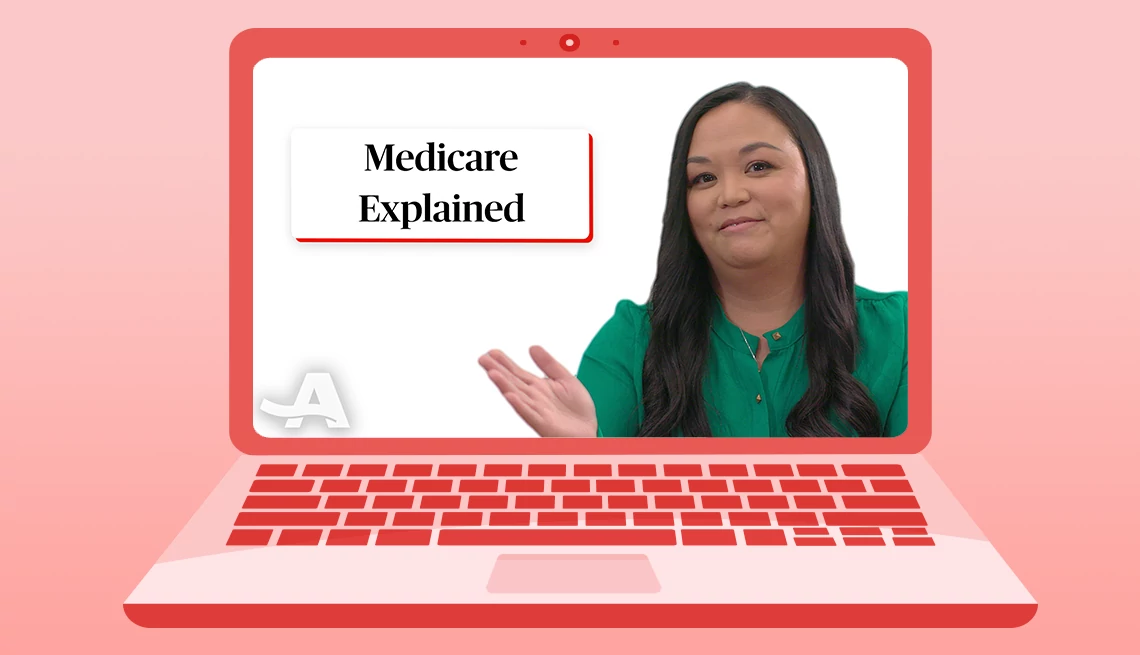









.jpg?crop=true&anchor=13,195&q=80&color=ffffffff&u=lywnjt&w=2008&h=1154)





























